 |
Scientific nameSpalgis epeus (Westwood) (=Spalgis epius (Westwood))
Common nameApefly
Taxonomic positionLepidoptera: Lycaenidae: Miletinae
DiagnosisMale: Upperside, both wings violet-brown. Forewing with a white quadrate spot from the end of the discoidal cell. Underside, both wings greyish-white, with indistinct pale brown oval basal marks and several outer transverse interrupted zigzag lines.
Female: Upperside, both wings paler. Forewing with a broader diffused white discal space, and a blackish disco-cellular lunular mark. Cilia whitish. Underside, both wings whiter, markings bolder. Antennae reddish, with black and white basal articulations. Legs banded with brown. The male is very constant in its markings, but the female varies considerably. The upperside of the forewing has a diffused white patch on the disc as small as in the male, in extreme cases this patch occupies the whole surface except a costal and outer even border of the ground colour and the hindwing has much whitish diffused over the disc. Larva / caterpillar: Pale green, short, stout, and fleshy, with hidden head and limbs covered with white mealy material; dorsal and lateral sides bear a fringe of long reddish brown bristles. Full grown / older larvae darker and greyish, considerably larger, with the body outline ellipsoidal. Pupa: Rather characteristic, with a monkey-like or phantom-like appearance, attached to the substrate. The common name of the butterfly, "apefly", is derived from the ape-like face of the pupa. Images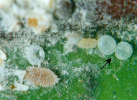 Eggs Eggs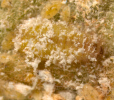
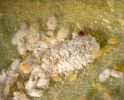
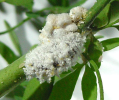
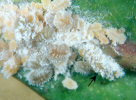 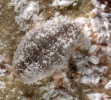
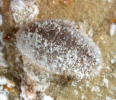
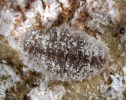
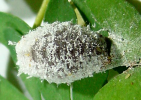 Larva Larva


 Pupa Pupa Adult - Male and female, dorsal view and ventral view Adult - Male and female, dorsal view and ventral view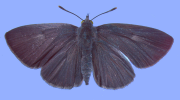
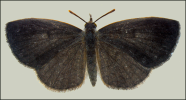
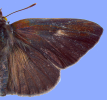 Adult male Adult male Adult female, dorsal and ventral sides Adult female, dorsal and ventral sides
Biology / hostsIn India, Spalgis epeus is the most common predator of mealybugs such as Coccidohystrix insolita (Green), Rastrococcus iceryoides (Green), Planococcus lilacinus
(Cockerell), and Planococcus citri (Risso), and also aphids. The caterpillars are covered with white mealy material, which is hard to detect amidst mealybugs and serves as an excellent camouflage (Ayyar, 1929; Puttarudriah & Channabasavanna, 1957). The fringe of long bristles about the sides and front of the body is used in shoveling the waxy covering of the host onto its back. The older larvae are considerably larger and markedly resemble syrphid larvae (Aitken, 1894). Pupation takes place in the mealybug colony and the pupa has a rather characteristic monkey-like or phantom-like appearance, and is known as the monkey-face pupa (Ayyar, 1929).
References
|
